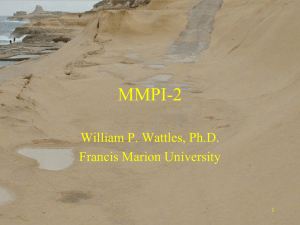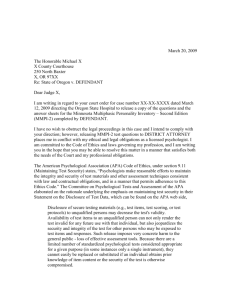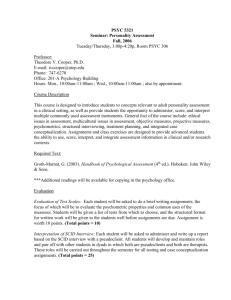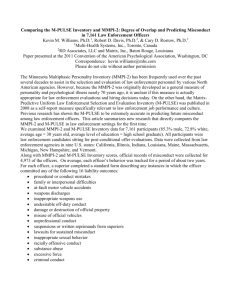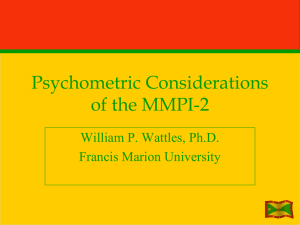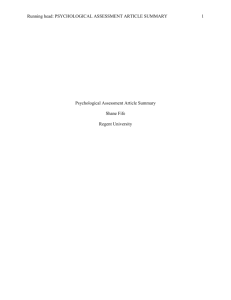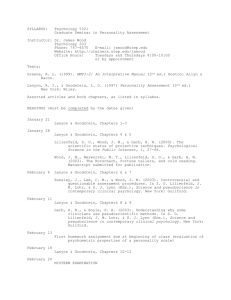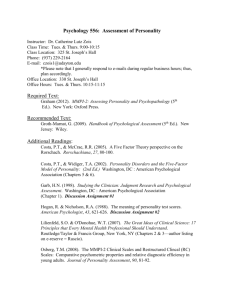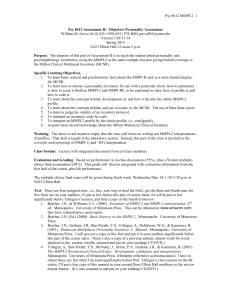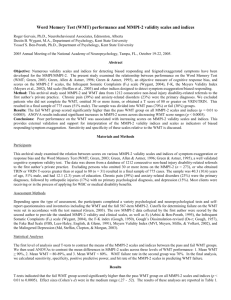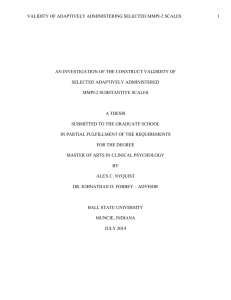Native Americans and the MMPI-2
advertisement
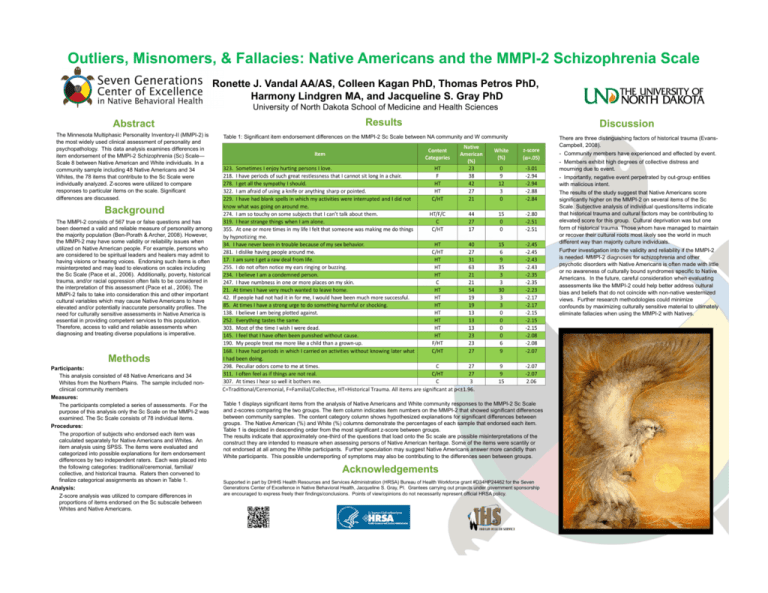
Outliers, Misnomers, & Fallacies: Native Americans and the MMPI-2 Schizophrenia Scale Ronette J. Vandal AA/AS, Colleen Kagan PhD, Thomas Petros PhD, Harmony Lindgren MA, and Jacqueline S. Gray PhD University of North Dakota School of Medicine and Health Sciences Abstract The Minnesota Multiphasic Personality Inventory-II (MMPI-2) is the most widely used clinical assessment of personality and psychopathology. This data analysis examines differences in item endorsement of the MMPI-2 Schizophrenia (Sc) Scale— Scale 8 between Native American and White individuals. In a community sample including 48 Native Americans and 34 Whites, the 78 items that contribute to the Sc Scale were individually analyzed. Z-scores were utilized to compare responses to particular items on the scale. Significant differences are discussed. Results Table 1: Significant item endorsement differences on the MMPI-2 Sc Scale between NA community and W community There are three distinguishing factors of historical trauma (EvansCampbell, 2008). - Community members have experienced and effected by event. - Members exhibit high degrees of collective distress and mourning due to event. - Importantly, negative event perpetrated by out-group entities with malicious intent. The results of the study suggest that Native Americans score significantly higher on the MMPI-2 on several items of the Sc Scale. Subjective analysis of individual questions/items indicate that historical trauma and cultural factors may be contributing to elevated score for this group. Cultural deprivation was but one form of historical trauma. Those whom have managed to maintain or recover their cultural roots most likely see the world in much different way than majority culture individuals. Background The MMPI-2 consists of 567 true or false questions and has been deemed a valid and reliable measure of personality among the majority population (Ben-Porath & Archer, 2008). However, the MMPI-2 may have some validity or reliability issues when utilized on Native American people. For example, persons who are considered to be spiritual leaders and healers may admit to having visions or hearing voices. Endorsing such items is often misinterpreted and may lead to elevations on scales including the Sc Scale (Pace et al., 2006). Additionally, poverty, historical trauma, and/or racial oppression often fails to be considered in the interpretation of this assessment (Pace et al., 2006). The MMPI-2 fails to take into consideration this and other important cultural variables which may cause Native Americans to have elevated and/or potentially inaccurate personality profiles. The need for culturally sensitive assessments in Native America is essential in providing competent services to this population. Therefore, access to valid and reliable assessments when diagnosing and treating diverse populations is imperative. Further investigation into the validity and reliability if the MMPI-2 is needed. MMPI-2 diagnoses for schizophrenia and other psychotic disorders with Native Americans is often made with little or no awareness of culturally bound syndromes specific to Native Americans. In the future, careful consideration when evaluating assessments like the MMPI-2 could help better address cultural bias and beliefs that do not coincide with non-native westernized views. Further research methodologies could minimize confounds by maximizing culturally sensitive material to ultimately eliminate fallacies when using the MMPI-2 with Natives. Methods Participants: This analysis consisted of 48 Native Americans and 34 Whites from the Northern Plains. The sample included nonclinical community members Measures: The participants completed a series of assessments. For the purpose of this analysis only the Sc Scale on the MMPI-2 was examined. The Sc Scale consists of 78 individual items. Procedures: The proportion of subjects who endorsed each item was calculated separately for Native Americans and Whites. An item analysis using SPSS. The items were evaluated and categorized into possible explanations for item endorsement differences by two independent raters. Each was placed into the following categories: traditional/ceremonial, familial/ collective, and historical trauma. Raters then convened to finalize categorical assignments as shown in Table 1. Analysis: Z-score analysis was utilized to compare differences in proportions of items endorsed on the Sc subscale between Whites and Native Americans. Discussion C=Tradi(onal/Ceremonial, F=Familial/Collec(ve, HT=Historical Trauma. All items are significant at p<±1.96. Table 1 displays significant items from the analysis of Native Americans and White community responses to the MMPI-2 Sc Scale and z-scores comparing the two groups. The item column indicates item numbers on the MMPI-2 that showed significant differences between community samples. The content category column shows hypothesized explanations for significant differences between groups. The Native American (%) and White (%) columns demonstrate the percentages of each sample that endorsed each item. Table 1 is depicted in descending order from the most significant z-score between groups. The results indicate that approximately one-third of the questions that load onto the Sc scale are possible misinterpretations of the construct they are intended to measure when assessing persons of Native American heritage. Some of the items were scantily or not endorsed at all among the White participants. Further speculation may suggest Native Americans answer more candidly than White participants. This possible underreporting of symptoms may also be contributing to the differences seen between groups. Acknowledgements Supported in part by DHHS Health Resources and Services Administration (HRSA) Bureau of Health Workforce grant #D34HP24462 for the Seven Generations Center of Excellence in Native Behavioral Health, Jacqueline S. Gray, PI. Grantees carrying out projects under government sponsorship are encouraged to express freely their findings/conclusions. Points of view/opinions do not necessarily represent official HRSA policy.
